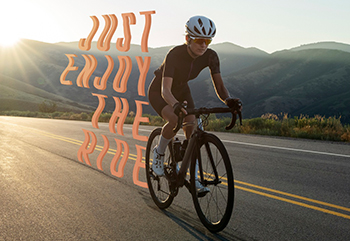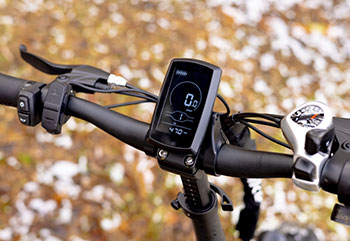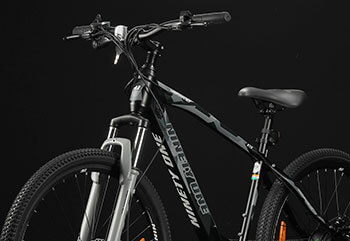Bicycle Anatomy that every cyclist must know

Cycles are some of the best things in the world; there is little that can be compared to riding an amazing bicycle; after all, it's one of the simplest pleasures of life. Cycling can offer us the exercise we need or the thrill we seek; it's also a reasonable investment into a healthier and greener future. After the pandemic, many citizens have shifted to a life of cycling, and in fact, they are commuting to work or tackling dangerous trails and pushing the limit of their bodies. Today, there is a cycle for everyone in the market. We have electric cycles, hybrid cycles, mountain bikes, and road cycles. There is something for each and every customer. Cycles are easily becoming the confidante and best friends that we were looking for! However, as a cyclist, one must know a few things, and that happens to be bicycle maintenance and the anatomy of a cycle. A cycle is made of various parts, and each of these parts is more functional than the other; as a cyclist, it's important to be well-versed in these important parts. Let's take a look:
- Fork: A fork is a popular terminology used to hold the front tyre of the cycle. This portion can be rigid, or it can have a suspension, depending on the type of bicycle you own. An MTB cycle usually has a suspension that offers a smooth and jerk-free ride to the cyclist. Our handlebars are used to steer a fork and the front wheel of the cycle.
- Tubes: There are four main types of tubes in a cycle, namely top, down, seat, and head tubes. These tubes play important functions in keeping the cycle together. The head tube is responsible for connecting the fork with the rest of the cycle. It is also important to connect the headset. The top tube runs on the top of the frame of the cycle, and it also integrates rear brake cables in certain cycles. Third, the down tube is the widest part of the frame of the cycle and connects to the head tube. Lastly, the seat tube connects the top tube with the bottom bracket.

- Handlebars: Handlebars are an important part of a cycle. Just like cars have steering wheels. Similarly, bicycles have handlebars. These could be dropped handlebars like on road bicycles, or they could be flat handlebars like on mountain cycles. A handlebar steers the fork and the front wheel of a cycle, therefore helping us change the direction.
- Saddle and Seatpost: Simply said, a saddle is where we sit on the cycle. There are various types of saddles available, depending on the style of the cycle. The Seatpost is attached to the seat tube, and it can be long. A seat post is where we attach our saddles, and there is also a seat clamp that keeps it secure.
- Chainset and cranks: Chainsets are a part of the bottom bracket of a cycle. A chainset consists of gears and can be double, triple, or even single. Cranks are connected to the chainset and happen to be the arms to which pedals are attached.
- Pedals: One doesn't need an explanation for these; pedals are what we use to ride the cycle and can be flat or platform pedals and even clip-in pedals. Pedals are connected to the cranks.
- Chains: Chains are wrapped around the chainset as well as the gears; as we pedal, these chains move to propel the bike forward.

- Derailleur: There are two main kinds of derailleur: the front and the rear derailleur. The front derailleur is part of cycles which has double or even triple chainsets. The front derailleur moves the chains up and down using the cables attached to a gear lever. Rear derailleurs are far more common than front derailleurs, and they are in most bikes except single-speed cycles, which don't have any gears. The rear derailleur works the same way as the front derailleur.
- Cassette: These are cogs around which the chains wrap themselves.
- Brakes and brake pads: One doesn't need an introduction to brakes. These are mechanisms that tighten and release to stop or pause the cycle. Their many types of brakes, but broadly they fall into two categories. We have sophisticated and efficient disc brakes, which are further classified into mechanical or hydraulic. We also have rim brakes which can be further classified into caliper brakes, v-brakes, and cantilever brakes. Brake pads, on the other hand, are attached to the brake and push against the wheel rims to stop the bicycle.
- Headset: A headset connects the head tube to the front fork. This enables the fork to rotate and steer the cycle. A headset is a rather crucial part of every cycle
- Brake/ Gear Levers: These are easily visible on a cycle and are a foundational part of any bike. The brake and gear levers are attached to the handlebars of a cycle. Pulling these levers will enable the cycle brakes to pause or slow the bicycle. Moving the levers laterally also helps in changing the gears of a cycle. There are two main types of shifters one is a twin-lever, and the other is an electronically controlled shifter.

- Suspension: An integral part of the cycle. The purpose of a suspension is to provide control over rugged, unpredictable, and treacherous terrains such as mountain trails or potholed roads. A suspension comes with shock absorbers. A bicycle can typically have no suspension, or it can have a front suspension or a full suspension.
The anatomy of a cycle might seem tricky at first, but that's not the case at all. The more we familiarize ourselves with our cycles, the better we'll get at identifying the different parts. Not all cycles possess all of the parts. A mountain cycle like the Defeatr Pro 29T - New Edition by Ninety One Cycles will have additional parts as compared to a road bicycle like the Tracer R14 by Ninety One Cycles.
- Bicycle
- Anatomy
- Must Know
Related Blogs

Cycling Adventures
Top 10 Cycling Events in India You Should Know AboutCycling has become an obsession in India, rather than just a mode of transportation. Cycling events have taken center stage in the country, since there is an increasing emphasis on fitness, adventure, and environmental awareness.

Electric Bicycle
A Novice's Guide To E-Bikes: Everything You Need To Know About Electric BicyclesElectric bicycles are creating waves amongst bicycle enthusiasts, but what is it that everyone is loving about them and why should you know all about them? Read here to know more.

Electric Bicycle
How To Maintain Your Electric Bicycle?While E-bikes are super convenient and easy to use, you have to make sure you maintain and take care of them from time-to-time. Here’s what an E-bike requires out of you.
